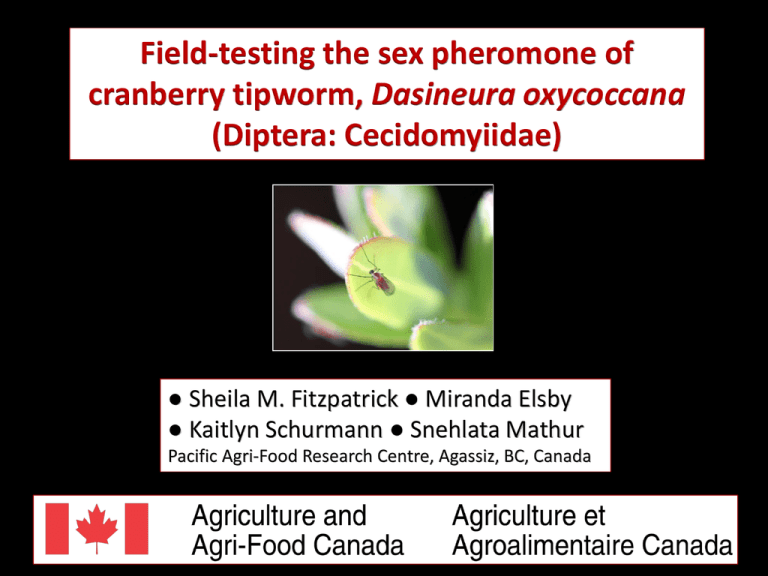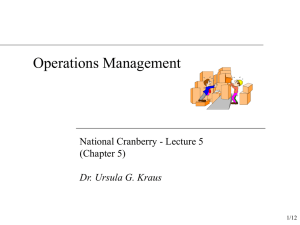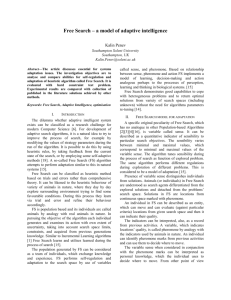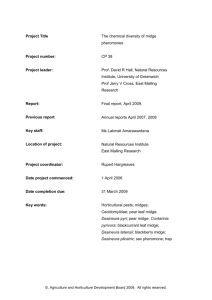
Field-testing the sex pheromone of
cranberry tipworm, Dasineura oxycoccana
(Diptera: Cecidomyiidae)
● Sheila M. Fitzpatrick ● Miranda Elsby
● Kaitlyn Schurmann ● Snehlata Mathur
Pacific Agri-Food Research Centre, Agassiz, BC, Canada
• Female cranberry tipworms produce and release sex pheromone.
• The sex pheromone is volatile and airborne.
• Males detect pheromone molecules and fly toward females.
Landry
• The sex pheromone was identified by Regine Gries,
Grigori Khaskin and Gerhard Gries at Simon Fraser University.
• “Populations of the gall midge Dasineura oxycoccana on
cranberry and blueberry produce and respond to different
pheromones” by S. Fitzpatrick, R. Gries, G. Khaskin, D. Peach, J.
Iwanski, G. Gries in Journal of Chemical Ecology 39(1): 37-49;
2013.
• The sex pheromone is a potential monitoring tool for cranberry
tipworm.
• Here I report the outcome of field tests of the sex pheromone
on cranberry farms in British Columbia, Canada.
•
Funded by AAFC (DIAP partnership with LMHIA), BCCMC, BCCGA and Investment Agriculture Foundation.
Chemistry of Cranberry Tipworm Pheromone
The parent molecule is a straight-chain 17-carbon alkene with two functional groups.
OAc
C
C
C
C
C
C
C
C
C
C
C
C
C
C
OAc
The molecule is named 2, 14-diacetoxy-8-heptadecene.
This racemic molecule is a mixture of 4 optical isomers.
C
C
C
Only one optical isomer is Cranberry Tipworm Pheromone
OAc
(R)
C
C
C
C
C
C
C
C
C
C
C
C
C
C
C
C
C
C
C
C
C
C
C
C
C
C
C
C
C
C
C
C
C
C
C
C
C
C
C
OAc
(S)
C
C
C
(S)
OAc
C
C
OAc
(R)
C
C
(R)
OAc
C
C
OAc
(S)
C
C
(R)
OAc
C
C
C
C
C
C
C
C
C
C
C
C
C
C
C
C
(S)
OAc
C
C
• CTW pheromone was tested on two
farms in 2012.
• Traps were baited with the isomer
(S,S)-2,14-diacetoxy-8-heptadecene,
or racemic pheromone or a blank lure.
Male cranberry tipworm
J.-F. Landry photo
Average number
Tipworm males in traps baited with single isomer CTW pheromone
Dotted lines show Delegate sprays
number
Average
Average number
Tipworm
Tipwormmales
malescaught
caughtinintraps
trapsbaited
baitedwith
withCTW
CTWpheromone
pheromone
On this farm,
the number of CTW males
caught in traps baited with
CTW pheromone …
Average Percent
Shoot tips infested with eggs, larvae or pupae
… was a good predictor of
the percent of shoot tips infested
with CTW eggs, larvae or pupae.
Increased trap catch
on July 11
corresponded to …
Number per 10 shoot tips
Shoot tips infested with eggs, larvae or pupae
… the first major increase in
immatures (week 8).
Eggs
First Instars
Second Instars
Third Instars
Pupae
J.-F. Landry photos
• The preceding graphs show that single isomer pheromone
has potential to be an excellent monitoring tool.
• Unfortunately, synthesis of this single isomer
(S,S)-2,14-diacetoxy-8-heptadecene is very expensive.
• Therefore, the single isomer pheromone will not be available
commercially.
• The following graph shows the attractiveness of racemic
2,14-diacetoxy-8-heptadecane, which is less expensive to
synthesize.
• Also shown is the attractiveness of traps to females.
Tipworm males caught in traps baited with single isomer
or racemic
pheromone
Single isomer
Average number
Racemic
Average number
Tipworm females
were caught in all traps, regardless of bait.
• Racemic 2,14-diacetoxy-8-heptadecane is much less
attractive than is the single isomer (S,S)-2,14-diacetoxy-8heptadecene.
• Monitoring with racemic will not provide precise information
about activity of cranberry tipworm adults.
• Female cranberry tipworms entered all traps without
discriminating among baits.
• Therefore, in 2013 we tested the relationship between
number of females caught in unbaited traps and
percentage of shoots containing immatures (eggs, larvae,
pupae).
Average number
Tipworm females caught in unbaited white sticky traps
On this farm (and all others),
the number of females
caught in unbaited traps …
% of shoots infested with eggs, larvae or pupae
… was a poor indicator of the
percent of shoot tips infested
with CTW eggs, larvae or pupae.
General, somewhat disappointing, conclusions
• Cranberry tipworm sex pheromone is very attractive to
tipworm males but is prohibitively expensive to synthesize
and therefore is not available for use on farms.
• The number of female tipworms attracted to unbaited traps
does not provide precise information about the percentage
of shoots infested with immature tipworms.
• The most accurate way to detect cranberry tipworms is the
method of collecting a sample of shoot tips then examining
them under the microscope to count eggs, larvae and pupae.
An optimistic and encouraging observation
• The recently registered insecticide Movento (spirotetramat),
applied AFTER BLOOM, is a very effective management tool.
D
M De
M
D
live immatures
dead
live & dead
×
empty
cocoons










